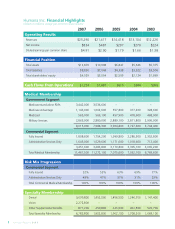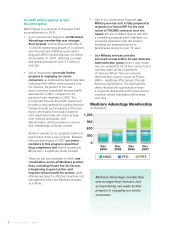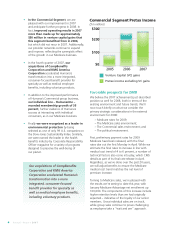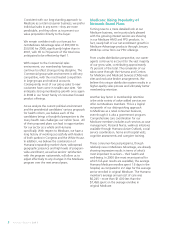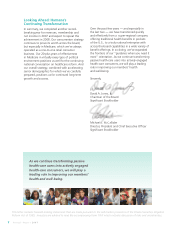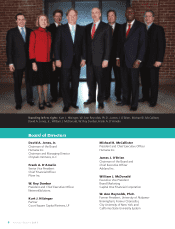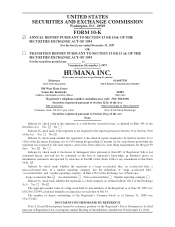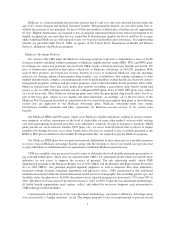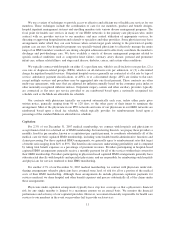Humana 2007 Annual Report Download - page 13
Download and view the complete annual report
Please find page 13 of the 2007 Humana annual report below. You can navigate through the pages in the report by either clicking on the pages listed below, or by using the keyword search tool below to find specific information within the annual report.PART I
ITEM 1. BUSINESS
General
Headquartered in Louisville, Kentucky, Humana Inc., referred to throughout this document as “we,” “us,”
“our,” the “Company” or “Humana,” is one of the nation’s largest publicly traded health and supplemental
benefits companies, based on our 2007 revenues of $25.3 billion. We are a full-service benefits solutions
company, offering a wide array of health and supplemental benefit plans for employer groups, government
benefit programs, and individuals. As of December 31, 2007, we had approximately 11.5 million members in our
medical benefit plans, as well as approximately 6.8 million members in our specialty products. During 2007,
71% of our premiums and administrative services fees were derived from contracts with the federal government,
including 17% related to our contracts in Florida with the Centers for Medicare and Medicaid Services, or CMS,
and 12% related to our military services contracts. Under our CMS contracts in Florida, we provide health
insurance coverage to approximately 507,700 members as of December 31, 2007.
We were organized as a Delaware corporation in 1964. Our principal executive offices are located at 500
West Main Street, Louisville, Kentucky 40202, the telephone number at that address is (502) 580-1000, and our
website address is www.humana.com.
This Annual Report on Form 10-K contains both historical and forward-looking information. See
Item 1A.—Risk Factors for a description of a number of factors that could adversely affect our results or
business.
Business Segments
We manage our business with two segments: Government and Commercial. The Government segment
consists of beneficiaries of government benefit programs, and includes three lines of business: Medicare,
Military, and Medicaid. The Commercial segment consists of members enrolled in our medical and specialty
products marketed to employer groups and individuals. We identified our segments in accordance with the
aggregation provisions of Statement of Financial Accounting Standards (SFAS) No. 131, Disclosures About
Segments of an Enterprise and Related Information, or SFAS 131,which aggregates products with similar
economic characteristics. These characteristics include the nature of customer groups as well as pricing, benefits,
and underwriting requirements. These segment groupings are consistent with information used by our Chief
Executive Officer.
The results of each segment are measured by income before income taxes. We allocate all selling, general
and administrative expenses, investment and other revenue, interest expense, and goodwill, but no other assets or
liabilities, to our segments. Members served by our two segments often utilize the same medical provider
networks, enabling us to obtain more favorable contract terms with providers. Our segments also share indirect
overhead costs and assets. As a result, the profitability of each segment is interdependent.
3


